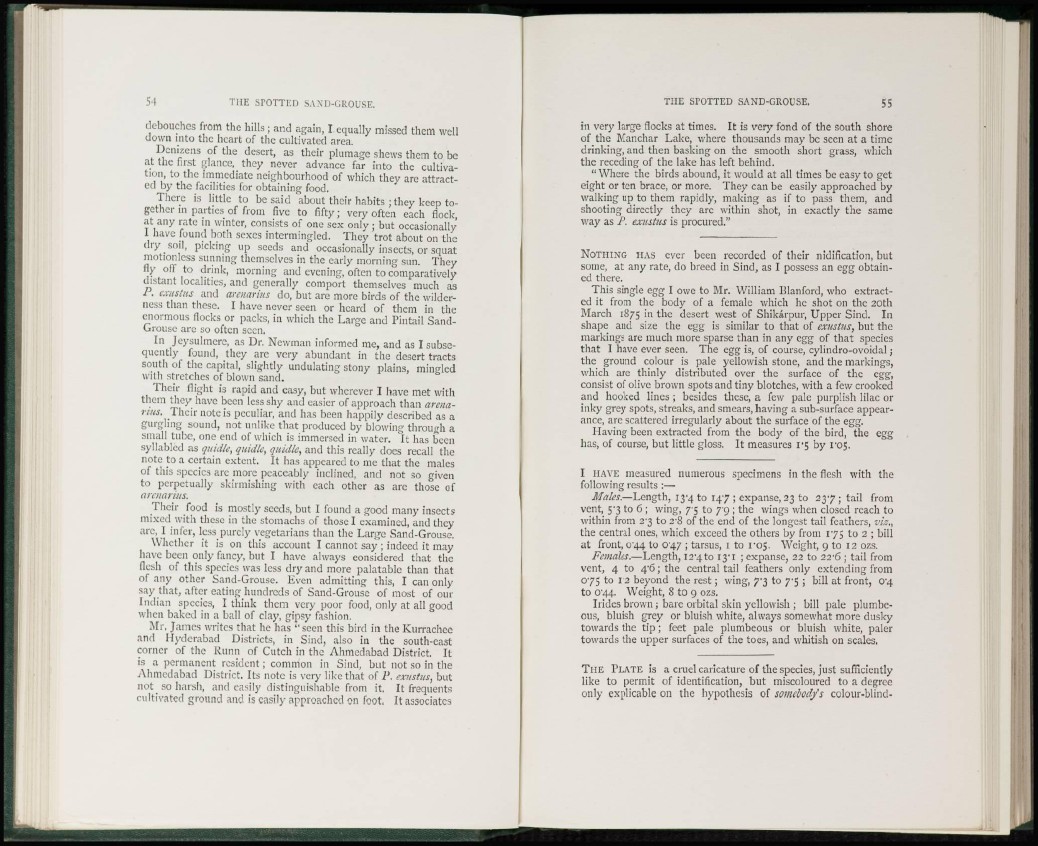
debouches from the hills ; and again, I equally missed them well
down into the heart of tbe cultivated area.
Denizens of the desert, as their plumage shews them to be
at the first glance, they never advance far into the cultivation,
to the immediate neighbourhood of which they are attracted
by the facilities for obtaining food.
There is little to be said about their habits ; they keep together
in parties of from five to fifty; very often each flock,
at any rate in winter, consists of one sex only; but occasionally
I have found both sexes intermingled. They trot about on the
dry soil, picking up seeds and occasionally insects, or squat
motionless sunning themselves in the early morning sun. They
fly off to drink, morning and evening, often to comparatively
distant localities, and generally comport themselves much as
P. exustus and arenarius do, but are more birds of the wilderness
than these. I have never seen or heard of them in the
enormous flocks or packs, in which the Large and Pintail Sand-
Grouse are so often seen.
In Jeysulmcre, as Dr. Newman informed me, and as I subsequently
found, they are very abundant in the desert tracts
south of the capital, slightly undulating stony plains, mingled
with stretches of blown sand.
Their flight is rapid and easy, but wherever I have met with
them they have been less shy and easier of approach than arenarius.
Their note is peculiar, and has been happily described as a
gurgling sound, not unlike that produced by blowing through a
small tube, one end of which is immersed in water. It has been
syllabled as quidle, quidle, quidle, and this really does recall the
note to a certain extent. It has appeared to me that the males
of this species arc more peaceably inclined, and not so given
to perpetually skirmishing with each other as are those of
arenarius.
Their food is mostly seeds, but I found a good many insects
mixed with these in the stomachs of those I examined, and they
are, I infer, less purely vegetarians than the Large Sand-Grouse.
Whether it is on this account I cannot say ; indeed it may
have been only fancy, but I have always considered that the
flesh of this species was less dry and more palatable than that
of any other Sand-Grouse. Even admitting this, I can only
say that, after eating hundreds of Sand-Grouse of most of our
Indian species, I think them very poor food, only at all good
when baked in a ball of clay, gipsy fashion.
Mr. James writes that he has "seen this bird in the Kurrachee
and Hyderabad Districts, in Sind, also in the south-east
corner of the Runn of Cutch in the Ahmedabad District. It
is a permanent resident; common in Sind, but not so in the
Ahmedabad District. Its note is very like that of P. exustus, but
not so harsh, and easily distinguishable from it. It frequents
cultivated ground and is easily approached on foot. It associates
in very large flocks at times. It is very fond of the south shore
of the Manchar Lake, where thousands may be seen at a time
drinking, and then basking on the smooth short grass, which
the receding of the lake has left behind.
"Where the birds abound, it would at all times be easy to get
eight or ten brace, or more. They can be easily approached by
walking up to them rapidly, making as if to pass them, and
shooting directly they arc within shot, in exactly the same
way as P. exustus is procured."
NOTHING HAS ever been recorded of their nidification, but
some, at any rate, do breed in Sind, as I possess an egg obtained
there.
This single egg I owe to Mr. William ISlanford, who extracted
it from the body of a female which he shot on the 20th
March 1875 in the desert west of Shikarpur, Upper Sind. In
shape and size the egg is similar to that of exustus, but the
markings are much more sparse than in any egg of that species
that I have ever seen. The egg is, of course, cylindro-ovoidal;
the ground colour is pale yellowish stone, and the markings,
which are thinly distributed over the surface of the egg,
consist of olive brown spots and tiny blotches, with a few crooked
and hooked lines ; besides these, a few pale purplish lilac or
inky grey spots, streaks, and smears, having a sub-surface appearance,
are scattered irregularly about the surface of the egg.
Having been extracted from the body of the bird, the egg
has, of course, but little gloss. It measures 1*5 by ro5.
I HAVE measured numerous specimens in the flesh with the
following results :—
Males.—Length, I3'4 to 147 ; expanse, 23 to 237; tail from
vent, 5'3 to 6 ; wing, 75 to 79 ; the wings when closed reach to
within from 2'3 to 2'8 of the end of the longest tail feathers, viz.,
the central ones, which exceed the others by from 175 to 2 ; bill
at front, 044 to 047 ; tarsus, 1 to i-o5. Weight, 9 to 12 ozs.
Females.—Length, l2'4to 13-1 ; expanse, 22 to 22'6 ; tail from
vent, 4 to 4'6; the central tail feathers only extending from
075 to V2 beyond the rest; wing, 7'3 to 7'5 ; bill at front, 0'4
to 044. Weight, 8 to 9 ozs.
Irides brown; bare orbital skin yellowish ; bill pale plumbeous,
bluish grey or bluish white, always somewhat more dusky
towards the tip; feet pale plumbeous or bluish white, paler
towards the upper surfaces of the toes, and whitish on scales.
THE PLATE is a cruel caricature of the species, just sufficiently
like to permit of identification, but miscoloured to a degree
only explicable on the hypothesis of somebody's colour-blind